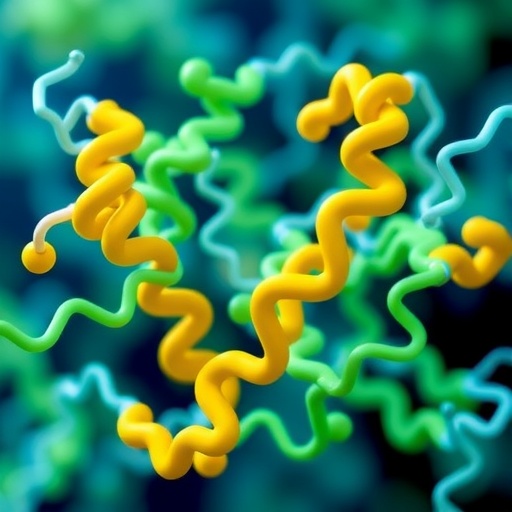In a groundbreaking advancement in the field of computational biology, a team of researchers has unveiled a novel protein-ligand molecular docking model known as DeepMice. This innovative model aims to optimize and refine the drug discovery process by employing advanced multilevel mapping modules. The publication documenting this significant development appears in the 2025 issue of Molecular Diversity, marking a pivotal moment in the ongoing quest for efficient and effective drug design strategies.
DeepMice represents a comprehensive approach to molecular docking that surpasses traditional techniques, addressing the inherent limitations associated with conventional models. Traditional docking methodologies often struggle with accurately predicting the binding affinities and orientations of ligands to target proteins, leading to inefficiencies in identifying viable drug candidates. The complexities of protein-ligand interactions, influenced by numerous factors including conformational flexibility and ligand specificity, necessitate sophisticated computational models that can adapt to these challenges.
At the core of DeepMice is its multilevel mapping architecture, which integrates various layers of data processing to enhance predictive accuracy. This approach allows researchers to dissect the intricate relationships between different molecular components, thereby providing a clearer picture of how ligands interact with their respective protein targets. By leveraging machine learning techniques, DeepMice can learn from vast datasets, enabling it to uncover patterns that may not be immediately obvious through traditional analytical methods.
Another remarkable feature of DeepMice is its ability to incorporate structural data at multiple resolutions. This capability ensures that the model can account for both coarse-grained and fine-grained structural details, which is critical in understanding how slight variations in molecular configuration can influence binding interactions. The highly adaptive nature of this model positions it as a prominent tool for researchers looking to explore the nuances of protein-ligand interactions.
The implications of this research extend beyond mere academic interest. As drug discovery becomes increasingly complex, with an ever-expanding array of potential drug targets, the need for accurate predictive models is more pressing than ever. DeepMice’s enhanced docking capabilities could streamline the identification of promising drug candidates, significantly shortening the time and expense traditionally associated with the drug development process.
Moreover, the integration of multilevel mapping in DeepMice presents an exciting evolution in computational modeling. By enabling the model to simulate various biological scenarios, researchers can assess how alterations in molecular structure may affect binding affinity and specificity. This predictive power could revolutionize the development of tailored therapeutics, allowing for more personalized medicine strategies that take into account individual patient variations.
The research team’s commitment to accessibility further amplifies the impact of DeepMice. They have made the model available for public use, fostering collaboration and innovation within the scientific community. By providing other researchers with the tools necessary to utilize DeepMice, they are encouraging a paradigm shift in how drug discovery research is conducted. This openness aligns with a broader trend in scientific research, where sharing resources accelerates advancement and reproducibility.
Significantly, the potential applications of DeepMice extend beyond pharmaceuticals. The model’s ability to accurately predict protein-ligand interactions makes it applicable to fields such as biotechnology and environmental science. For instance, the model could facilitate the development of novel biocatalysts, enhancing industrial processes and contributing to more sustainable manufacturing practices. Additionally, environmental scientists could apply DeepMice to evaluate the interactions of pollutants with biological systems, paving the way for more effective strategies to mitigate environmental damage.
The publication of DeepMice is poised to spark interest among both academic researchers and industry professionals. As drug discovery initiatives continue to scale in complexity, the need for innovative computational tools becomes increasingly apparent. The introduction of DeepMice into the scientific toolkit may serve as a catalyst for breakthroughs that have previously seemed unattainable. From rare diseases to widespread conditions, the potential for new therapeutic discoveries made possible by this model is vast.
Furthermore, the intersection of artificial intelligence and molecular modeling presents an exciting frontier in drug design. The machine learning algorithms driving DeepMice not only enhance its predictive capabilities but also evolve as they are trained on more datasets. This characteristic of self-improvement means that the model will become increasingly proficient over time, adapting to newly learned information about molecular interactions and improving the accuracy of its predictions.
The advancement of DeepMice illustrates the transformative potential of collaborative research efforts. By combining expertise from diverse domains, the research team has created a model that stands to benefit numerous disciplines. Such interdisciplinary collaborations are essential in addressing the multifaceted challenges of drug discovery and developing innovative solutions that cultivate progress in healthcare.
In conclusion, DeepMice represents a significant leap forward in the field of molecular docking and protein-ligand interaction analysis. Its multilayered approach not only enhances predictive accuracy but also opens new avenues for exploration within drug discovery and beyond. As this model paves the way for more efficient and personalized therapeutic options, it is paving the path toward a new era of drug development that emphasizes precision and adaptability. The journey towards effective and efficient drug discovery is now more promising, chiefly due to the contributions of DeepMice.
Subject of Research: Novel protein-ligand molecular docking model
Article Title: DeepMice: a novel protein–ligand molecular docking model based on multilevel mapping modules
Article References:
Liu, J., Wang, Q., Jin, Y. et al. DeepMice: a novel protein–ligand molecular docking model based on multilevel mapping modules. Mol Divers (2025). https://doi.org/10.1007/s11030-025-11372-7
Image Credits: AI Generated
DOI:
Keywords: Protein-ligand interactions, molecular docking, drug discovery, machine learning, computational biology




